How to Choose a Proper Yixing Teapot for a Single Type of Tea
How to Choose a Proper Yixing Teapot for a Single Type of Tea
Choosing a proper Yixing Clay Teapot for your favorite tea is the most important aspect to reveal outstanding characteristics of your tea. No matter you are addict or just a novice to Yixing Teapot.
Part 1 – Yixing Teapot for a certain type of tea
Part 2 – Yixing Clay Types
Part 3 – Shapes of Yixing Teapot
Yixing Zisha Teapot has been commonly used and favored by tea lovers when brewing tea. It is often a great task for tea lovers to choose a proper Yixing Teapot for a certain type of tea as there’re so many kinds of Yixing Teapots. Furthermore, the clay type and the teapot shape play important aspect to reveal outstanding characteristics of your tea. A certain Yixing teapot is usually dedicated to a single type of tea.
Part 1 – Yixing Teapot for a certain type of tea
- Green Oolong (Light Oolong)
Clay Type: Zhu Ni (the best), Zi Ni, Hong Ni, Xiangpo Ni, Duan Ni
Teapot Shape: Round, Tall (relatively), Thinner walled
- Dark Oolong (Roasted Oolong)
Clay Type: Zi Ni, Di Cao Qing, Hong Ni, Xiangpo Ni
Teapot Shape: Flat, Medium thick walled

- Ripe Puerh (Shou Pu-erh)
Clay Type: Zi Ni, Hong Ni, Qingshui Ni, Di Cao Qing
Teapot Shape: Round or Square, Tall
- Raw Puerh (Sheng Pu-erh)
Clay Type: Zhu Ni, Hong Ni, Qingshui Ni, Di Cao Qing, Duan Ni
Teapot Shape: Round or Square

- Black Tea
Clay Type: Zi Ni, Hong Ni, Qingshui Ni, Di Cao Qing
Teapot Shape: Round, Tall (relatively), Small mounth
- Green Tea, White Tea and Yellow Tea
Clay Type: Duan Ni, Lv Ni
Teapot Shape: Round, Short body, Big mouth, Thinner walled
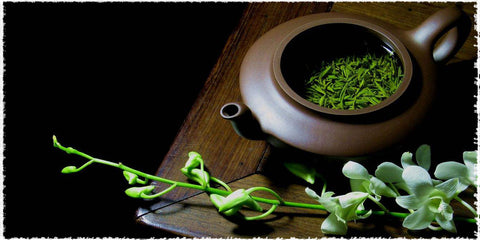
It is commonly seen that Green Tea and White Teas are brewed in porcelain or glass gaiwans and teapots as they can reveal the delicate taste and enjoy the full bloom of the tea leaves.
Generally you don’t often see green or white teas being brewed in a clay teapot. Many people think it will bake the leaves and make them constricted in such small teapot when brewing Green Tea, White Tea or Yellow Tea in Yixing Teapot. If the teapot is thin enough and allows a lot of movement for the leaves, then it is okay.
It’s not that you can’t get decent tasting green tea from an Yixing clay pot, it’s that a further comparison with porcelain or glass shows the latter two to be better. There’re also many Yixing teapot addicts asking me to recommend Yixing Teapot for Green Tea. Thin and light one is recommended for green tea.
Notes for brewing Green, White and Yellow Tea in Yixing Teapot
– Choose proper clay: Duan Ni and Lv Ni is thin and light which is good for brewing delicate teas
– Keep proper water temperature, 80c is better
– Keep the lid off
- Flavored Tea and Herbal Tea: Not recommend using Yixing Teapot
Yixing Teapots are very absorbent. It will absorb the flavor and affecting the taste of tea steeped in the future.
Part 2 – Yixing Clay Types
There’re three main types of Yixing Zisha Clay: Zi Ni, Zhu Ni and Lv Ni
- Zi Ni – The most common Type of Yixing Clay
Appear purple, dark purple, purple brown or purple red after firing.
Zi Ni, Qingshui Ni, Di Cao Qing are belonging to this main type.
- Zi Ni
Features: High in Iron components, granule in the clay is big, dual porosity structure which is good for air convection when brewing tea.
Recommendation: good for brewing fermented teas such as Ripe Pu-erh Tea, Black Tea, Oolong Tea.
Xi Shi Yixing Teapot – Zini
Fanggu Yixing Teapot – Zini
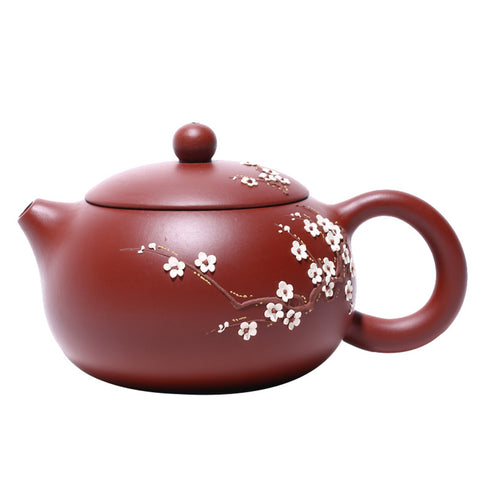
- Qingshui Ni
Features: Elegant and mild color, strong literati atmosphere, easy to control the temperature when brewing tea. Qing Shui Ni will develop a strong and mature color from long term use.
Recommendation: Black Tea, Pu-erh Tea
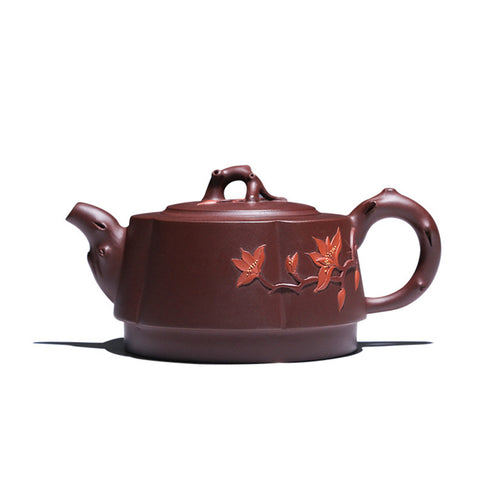
- Di Cao Qing
Features: Located at the bottom of a clay mine which yields the best quality, it is characteristic in being pure and uniformity, fine and smooth, being brown in color. It is commonly used in modern times by famous artistic. There’s “Ji Yan” (referring to the green-yellow chunk of clay in the Di Cao Qi ore) in the clay, which turns to “Jin Sha Yin Xian” (yellowish or goldish colored particles) after firing.
Recommendation: Black Tea, Puerh Tea, Oolong Tea
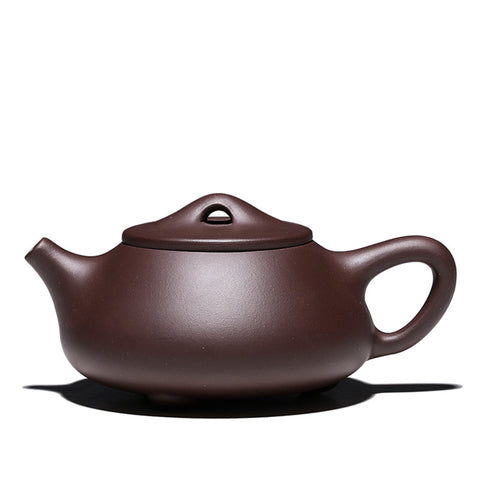
- Hong Ni (Red Clay)
Hong Ni is very scarce as it is located at the bottom of a clay mine. The raw clay material is orange yellow. After firing, it can have various shades of red and purple, depending on the level of iron it contains. Da Hong Ni and Zhu Ni are belonging to this type.
- Da Hong Ni
Feature: High in Iron components; the teapots made by this kind of clay appears color in red with slight yellowish, red with slight purple, yellow with slight red, the color is related to the firing temperature; good air permeability; best for brewing high aroma teas.
Recommendation: Oolong Tea, Puerh Tea
Ba Ban Yixing Teapot – Hong Ni
Hong Ni Ru Yi Teapot

- Zhu Ni
Feature: high in Iron components, Zhu Ni is fragile. Zhu Ni teapot characters of glossy and silk to the touch are from the original texture. It is very difficult to make a successful teapot of this clay, so the Zhu Ni teapot is usually small capacity.
The Zhu Ni teapot has a better “water color” (水色, a term used to describe the glossiness of the finished product). The glossiness here is not from “tea seasoning” or any artificial material, but is the original texture from the ore itself. It requires patience and craftsmanship to achieve the teapot with such a glossy “water color” appearance and texture.
Note: Warm the teapot before pouring boiling water promptly into it, for Zhuni has high constriction percentage, cannot resist instant temperature change.
Recommendation: Oolong Tea, Puerh Tea
III. Lv Ni
Lv Ni is tender; it is located at the top of mine. Compare to Zi Ni, it tolerates lower firing temperature and is more scare.
Duan Ni and Ben Shan Lv Ni are belonging to this type.
- Duan Ni
Feature: Duanni is also called Lao Tuanni which is common seen in Huanglong Shan, Yixing, Jiangsu Province. Duanni can be grind into fine particles to be used to blend. Being burning Duanni will become yellow in color, with very small amount of red spots. This kind of clay is of loosen and double air hole structure, that leads smooth cross-ventilation. Teapot made of Duanni is such a good choice to enjoy best teas.

Recommendation: as Duan Ni teapot is thin and light, it is great for Green Tea, White Tea and Yellow Tea. You can also brew Green Oolong Tea and Raw Puerh Tea. But not recommend for Black Tea and Ripe Puerh Tea
- Ben Shan Lv Ni
The origin mine is light green color. Ben Shan Lv Ni absorbs much moisture as it contains much quartz, causing big shrink and easy cracking while firing into teapot. Therefore, Ben Shan Lv Ni is usually easy to make small teapot, while big one is hardly to seen.
Recommendation: Great for brewing Green Tea, White Tea and Yellow Tea. You can also brew Green Oolong Tea and Raw Puerh Tea. But not recommend for Black Tea and Ripe Puerh Tea.

- Other kinds of Yixing Clay
- Jiang Po Ni
This clay was occasionally found in the early 90s when the Yixing government opened the “pottery capital road” from Dingshan to Yixing. This road must pass through the junction slope of Huanglong Mountain and Qinglong Mountain. In order to smooth the slope, the workers began to dig the slope and then found some Zisha raw ore, which was named “Xiangpo Ni” and also names “Gangpo Ni” by local people. “Xiangpo Ni” was discovered by accident and its stock is scarce.
Feature: light brown in the primary color, after firing turning to red with yellow, fresh color with obvious granular sensation, after seasoning the surface becoming “oil and wax”. It is a good variety of Zisha clay.
Recommendation: Oolong Tea, Puerh Tea
- Qing Hui Ni
Qing Hui Ni is a kind of clay which is made by Chen Fu processing from Duan Ni mine (Chen Fu is aging of origin mine. The origin mine will be drying, smashed, air-slaked, grinded, and then mixed evenly with water into clumps to be stored in damp cellar. This processing is the Chen Fu of zisha mine, by which the water will be evenly distributed and the organic substance will be fully decomposition to help oxidation of the clay). It will turn into grey-white or steel-gray color. It is a popular clay in late Ming and early Qing dynasties, while limited and rare in recent years. Qing Hui Ni is also called “sharkskin” because it is covered with many particles.
Feature: Teapot made of Qing Hui Ni is good air permeability, with simply and sedate feeling.
Recommendation: Oolong Tea, Puerh Tea
Part 3 – Shapes of Yixing Teapot
We also need to consider the shape the Yixing Teapot while choosing a proper one for a certain type of tea. The size / volume of the teapot is decided by customers favor but the shape will give much influence of the flavor and taste.
Round – The most common shape, simple and unpretentious.
High body and small mouth round teapot is a good choice for fermented teas, but too high which will cause loosing of flavor. The round teapot will make the tea sweeter and mellower.
Short body and big mouth round teapot is good for unfermented teas, such as Green Tea, White Tea, Yellow Tea which will well reveal the best refreshing taste around 85℃water temperature.
Round Yixing teapot is great for oolong teas, as it allows for proper air circulation and expansion of the tea leaves which will make best reveal of flavor of Oolong tea. Also, round teapots are considered a feminine design.

Flat – sense of stability
Flat teapot is best suited for highly oxidized strip black teas which are heated at very high temperatures. Tea leaves stably stay in the teapot and confidently release the aroma and mellow taste. When pouring the water, the water flow has some buffers to the short pot wall, with the narrow space inside the teapot, the tea will be easily infiltrated and gentle release its essence. For example: a teapot with long time brewing of roasted wuyi rock tea will conceal the heavy roasted huo wei and will perfectly reveal the yan yun of the tea.
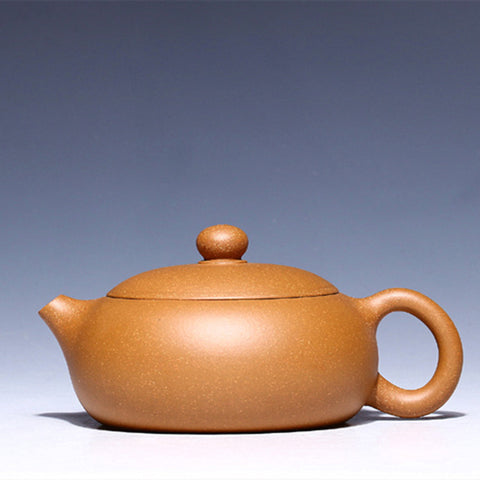
Square – stable and dignified feeling
The square design requires a mastery of the yixing teapot craft. Only the most skilled craftsmen dare to create this precise, proportionate flow of design. Tea is not easy to roll because of the angle inside of the square teapot. Square teapot is not suitable for Oolong tea as the fragrance will be stuffy. To the contrary, it is good to brew Ripe Puerh Tea as the aged flavor will be fully revealed.
There’re also many shapes of square teapot, such as rectangular, hexagon, octahedron and so on. Square shape Yixing teapot also focuses on the artistic aesthetic of “round implicated with square”. That means making the junctions between the lines to be smoother.
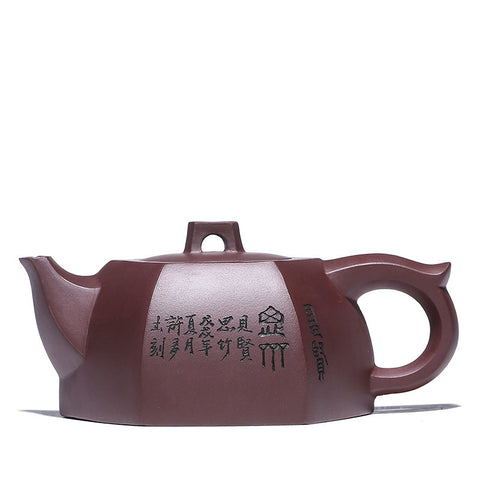
Reference: "How to Choose a Proper Yixing Teapot for a Single Type of Tea"